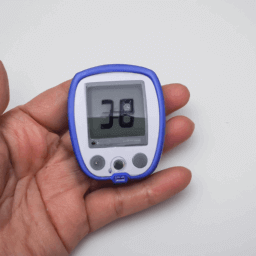What does a Pulse Oximeter measure
A pulse oximeter is a medical device that measures the oxygen saturation level in a person's blood. It works by shining a light through the skin and measuring the amount of light absorbed by the blood. The device then calculates the percentage of oxygen in the blood based on this measurement. The pulse oximeter also measures the person's heart rate by detecting the pulsations of blood through the arteries. This information is displayed on the device's screen in real-time. Pulse oximeters are commonly used in hospitals, clinics, and at home to monitor the oxygen levels of patients with respiratory or cardiovascular conditions. They are also used during surgeries and in emergency situations to quickly assess a person's oxygenation status. Overall, pulse oximeters are a non-invasive and convenient way to monitor a person's oxygen saturation and heart rate, providing important information for medical professionals to make informed decisions about a person's health.
What Does a Pulse Oximeter Measure?
A pulse oximeter is a small, non-invasive medical device that measures the oxygen saturation level in a person's blood. It is a useful tool for monitoring the health of individuals with respiratory conditions, such as asthma, chronic obstructive pulmonary disease (COPD), and pneumonia. It is also commonly used during surgical procedures and in intensive care units to monitor patients' oxygen levels.
How Does a Pulse Oximeter Work?
A pulse oximeter works by shining two different wavelengths of light through a person's skin and measuring the amount of light that is absorbed by the blood. Oxygenated blood absorbs more infrared light and allows more red light to pass through, while deoxygenated blood absorbs more red light and allows more infrared light to pass through. By measuring the ratio of infrared to red light, the pulse oximeter can determine the oxygen saturation level in the blood.
What is Oxygen Saturation?
Oxygen saturation is a measure of the amount of oxygen that is bound to hemoglobin in the blood. Hemoglobin is a protein in red blood cells that carries oxygen from the lungs to the rest of the body. Oxygen saturation is expressed as a percentage and represents the amount of hemoglobin that is bound to oxygen. A healthy person typically has an oxygen saturation level of 95% or higher.
What Are the Benefits of Using a Pulse Oximeter?
Using a pulse oximeter can provide several benefits, including:
- Early detection of low oxygen levels
- Monitoring the effectiveness of oxygen therapy
- Reducing the risk of complications during surgical procedures
- Monitoring the health of individuals with respiratory conditions
How to Use a Pulse Oximeter?
Using a pulse oximeter is a simple and painless process. The device is typically placed on the fingertip, earlobe, or toe, and a small amount of light is passed through the skin. The device then displays the oxygen saturation level on a screen. It is important to note that certain factors, such as nail polish, cold hands, and poor circulation, can affect the accuracy of the readings.
Conclusion
A pulse oximeter is a valuable tool for monitoring the oxygen saturation level in a person's blood. It is a non-invasive and painless way to detect low oxygen levels and monitor the effectiveness of oxygen therapy. It is important to use the device correctly and to be aware of factors that can affect the accuracy of the readings.
| Benefits of Using a Pulse Oximeter |
|---|
| Early detection of low oxygen levels |
| Monitoring the effectiveness of oxygen therapy |
| Reducing the risk of complications during surgical procedures |
| Monitoring the health of individuals with respiratory conditions |
| By www.zelect.in |
Sharing is caring!
Facebook Twitter Email
Recommended articles for Pulse Oximeter
Pulse Oximeter types and buying guide
-
Pulse oximeter buying guide. How to choose the right oximeter
-
What is a Pulse Oximeter
-
What are the Pulse Oximeter types. Which one is best?
-
What is the normal oxygen saturation on Pulse Oximeter
-
Which brand is best for Pulse Oximeter India
-
Does a Pulse Oximeter measure blood pressure
-
Does a Pulse Oximeter measure heart rate
-
Does Apple watch have Pulse Oximeter
-
How accurate is a Pulse Oximeter
-
What are the 2 readings on a Pulse Oximeter
-
Which finger to use for Pulse Oximeter
-
What does a Pulse Oximeter measure
-
What is a normal oxygen saturation reading on Pulse Oximeter
-
Can Pulse Oximeter detect sleep apnea


